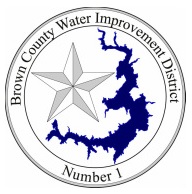
Brownwood News – The Board of Directors of the Brown County Water Improvement District #1 held their monthly meeting on Tuesday, March 16. Much of the meeting was devoted to discussing the big freeze event in February.
See previous story here.
Water District General Manager John Allen reported that his staff is still inspecting equipment at the water treatment plant and identifying damages. Current known damages to valves, pipes, pressure transmitters, etc. total about $10,000 in value, and he expects the final total will be about $20,000. All of that will be covered by insurance, minus a $1000 deductible.
Allen said that when the plant lost its electrical power on February 15, they “begged, borrowed, and stole” every propane heater they could find to keep the equipment working. Even then, the temperature inside the plant dipped to 12 degrees. He said he would like to work into future budgets the purchase of more propane heaters for future freeze events.
Allen is looking into the cost of backup generators for the plant. His initial information is that it would require two 1500-kw generators at an estimated cost of $1.5 – 2.0 million. He also asked for, and received authorization from the Board, to engage the engineering firm of Freese and Nichols for a design and estimate on the generators and improved plant winterization.
Part of the plant enhancements could include adding three new membrane filtration racks, which would increase treatment production by 3-million gallons per day. Currently the new membrane plant has a capacity of 9-million gallons per day. The older, conventional plant can treat 7.5-million gallons per day, if needed.
Allen also mentioned that the current filtration membranes have a rated life of ten years, but are now twelve years old. He said they are in good shape, but may need to be replaced sometime in the not-too-distant future. Also, he said the equipment, at twelve years of life, is in need of service.
During the freeze event, even with all the problems in the plant, they still managed to ship a peak of 10.1-million gallons of treated water in one day, which is greater than the biggest day in the summer of 9.5-million gallons, all the while maintaining the quality of the treated water within compliance standards.
Board President Bert Massey compared that to other cities, such as Abilene, that did not maintain water quality standards and necessitated a boil water notice for several days. He praised the treatment plant staff, GM Allen, and the City of Brownwood for cooperating and reducing water usage during the crisis. In addition he praised Board Member Johnny Hays and State Representative Dr. Glenn Rogers for their work in persuading Oncor to restore electrical power to the treatment plant. After recessing to executive session, Massey announced that the Board had voted to reward the treatment plant staff and GM Allen a cash stipend for their heroic work during the freeze crisis.
In other business:
*** The Board voted to approve the transfer of a 40-year lease agreement with Brent Carmack for a 50 x 15 parcel of land located adjacent to the Highway 279 bridge to Charlie Newton. Carmack owns Brown County Welding and has a dock-building business, but has sold that business to Newton.
*** Lake Patrol Chief Mark Davis reported on training activities with the Lake Patrol officers, and on the progress being made on the new fire pump boats being built. Davis also spoke about a problem in the dam area with vultures, which have taken up residence in the area and are causing lots of property damage and posing a health safety threat to the water coming out of the lake. He has applied for a Federal Depredation Permit, which would allow him to remove as many as 150 black vultures and 100 turkey vultures. Davis believes he can remove most of the vultures without killing them by using traps, snares, and effigy birds.
*** The Board received the financial report for January which showed total revenues to the District of $239,311 along with total expenses of $202,712, for an operating margin of $36,599.
*** Allen reported that the lake level is currently at 1422.05 feet, which is 3-feet below spillway level. He also reported that the District shipped an average of 5.3-million gallons of water per day in February.